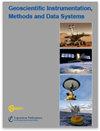从岩石薄片的能量色散 X 射线光谱扫描中自动绘制定量矿物学图谱的免费开源方法
IF 2.3
4区 地球科学
Q3 GEOSCIENCES, MULTIDISCIPLINARY
Geoscientific Instrumentation Methods and Data Systems
Pub Date : 2024-04-09
DOI:10.5194/egusphere-2024-1017
引用次数: 0
摘要
摘要。对岩石薄片中的矿物进行定量测绘可提供有关矿物丰度、大小和空间排列的数据,这些数据对许多地球科学和工程学科都很有用。虽然存在自动绘制矿物学图谱的方法,但这些方法通常价格昂贵,与专有软件相关,或需要编程技能,从而限制了其使用。在此,我们介绍一种免费的开源方法,用于从岩石薄片的能量色散光谱(EDS)扫描中自动绘制矿物学图谱。该方法在免费开源的 QGIS 地理信息系统和 Orfeo 工具箱中使用了随机森林机器学习图像分类算法。为了证明该方法的实用性,我们将其应用于波多黎各研究较多的 Rio Blanco 炭绿岩岩性的 14 个岩石薄片。通过我们的方法推断出的矿物丰度测量结果与之前通过 X 射线衍射和薄切片上的点计数推断出的矿物丰度测量结果相比,效果更佳。模型生成的矿物图谱与独立的人工划线矿物图谱的平均吻合率为 95%,在这些样本中,最富集相(斜长石)的准确率高达 96%,而最不富集相(磷灰石)的准确率则低至 72%。我们展示了 Orfeo 工具箱中默认的随机森林超参数对模型生成的矿物图谱产生了很高的准确性,并演示了用户如何确定矿物图谱对超参数值和输入特征的敏感性。这些结果表明,这种方法可用于生成岩石薄片中主要矿物相的精确地图,使用的是完全免费的开源应用程序。本文章由计算机程序翻译,如有差异,请以英文原文为准。
A free, open-source method for automated mapping of quantitative mineralogy from energy-dispersive X-ray spectroscopy scans of rock thin sections
Abstract. Quantitative mapping of minerals in rock thin sections delivers data on mineral abundance, size, and spatial arrangement that are useful for many geoscience and engineering disciplines. Although automated methods for mapping mineralogy exist, these are often expensive, associated with proprietary software, or require programming skills, which limits their usage. Here we present a free, open-source method for automated mineralogy mapping from energy dispersive spectroscopy (EDS) scans of rock thin sections. This method uses a random forest machine learning image classification algorithm within the QGIS geographic information system and Orfeo Toolbox, which are both free and open source. To demonstrate the utility of this method, we apply it to 14 rock thin sections from the well-studied Rio Blanco tonalite lithology of Puerto Rico. Measurements of mineral abundance inferred from our method compare favourably to previous measurements of mineral abundance inferred from X-ray diffraction and point counts on thin sections. The model-generated mineral maps agree with independent, manually-delineated mineral maps at a mean rate of 95 %, with accuracies as high as 96 % for the most abundant phase (plagioclase) and as low as 72 % for the least abundant phase (apatite) in these samples. We show that the default random forest hyperparameters in Orfeo Toolbox yielded high accuracy in the model-generated mineral maps, and we demonstrate how users can determine the sensitivity of the mineral maps to hyperparameter values and input features. These results show that this method can be used to generate accurate maps of major mineral phases in rock thin sections using entirely free and open-source applications.
求助全文
通过发布文献求助,成功后即可免费获取论文全文。
去求助
来源期刊

Geoscientific Instrumentation Methods and Data Systems
GEOSCIENCES, MULTIDISCIPLINARYMETEOROLOGY-METEOROLOGY & ATMOSPHERIC SCIENCES
CiteScore
3.70
自引率
0.00%
发文量
23
审稿时长
37 weeks
期刊介绍:
Geoscientific Instrumentation, Methods and Data Systems (GI) is an open-access interdisciplinary electronic journal for swift publication of original articles and short communications in the area of geoscientific instruments. It covers three main areas: (i) atmospheric and geospace sciences, (ii) earth science, and (iii) ocean science. A unique feature of the journal is the emphasis on synergy between science and technology that facilitates advances in GI. These advances include but are not limited to the following:
concepts, design, and description of instrumentation and data systems;
retrieval techniques of scientific products from measurements;
calibration and data quality assessment;
uncertainty in measurements;
newly developed and planned research platforms and community instrumentation capabilities;
major national and international field campaigns and observational research programs;
new observational strategies to address societal needs in areas such as monitoring climate change and preventing natural disasters;
networking of instruments for enhancing high temporal and spatial resolution of observations.
GI has an innovative two-stage publication process involving the scientific discussion forum Geoscientific Instrumentation, Methods and Data Systems Discussions (GID), which has been designed to do the following:
foster scientific discussion;
maximize the effectiveness and transparency of scientific quality assurance;
enable rapid publication;
make scientific publications freely accessible.
 求助内容:
求助内容: 应助结果提醒方式:
应助结果提醒方式:


